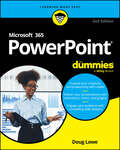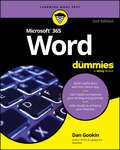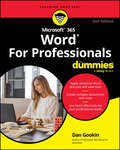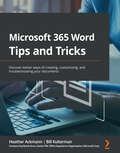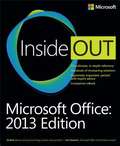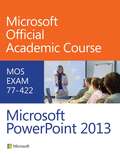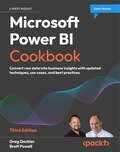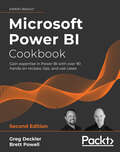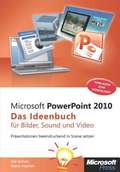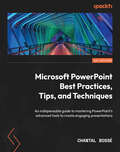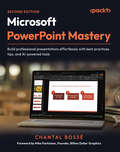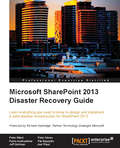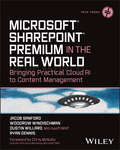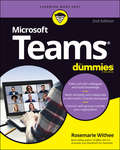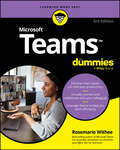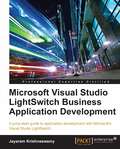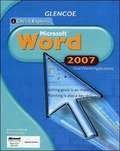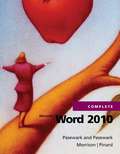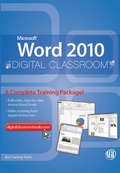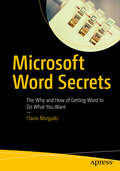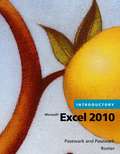- Table View
- List View
Microsoft 365 Portable Genius (Portable Genius)
by Lisa A. BuckiPower up your proficiency with this genius guide to popular Microsoft 365 apps Do you want to make your Microsoft 365 account a productivity behemoth? Do you want to squeeze every last bit of awesome from Word, Excel, and PowerPoint and learn a little more about Outlook, too? Microsoft 365 Portable Genius has got you covered. A seasoned tech expert and trainer, author Lisa A. Bucki shows you how to build Word documents, Excel workbooks, and PowerPoint presentations the right way, as well as how to use high-impact design techniques to make your documents pop. This book answers 11 key questions about how to make the most of Microsoft 365, providing genius tips as it leads you through the essentials. You’ll learn how to: Tackle common skills like creating files, adding basic content, navigating in a file, making selections, copying and moving content, and saving files Build a new Word document by using outlining, bullets and numbering, columns, and other features for creating and enhancing content Enhance Excel workbook files by organizing data on different sheets, filling entries, creating range names, and entering powerful, accurate formulas Develop a PowerPoint presentation by choosing the right layout for each slide and adding content to placeholders, and then transform it into an on-screen show with transitions and animations Add punchy design and branding by using text formatting, themes, and graphics in your files Use lists, tables, and charts to make data easier to interpret Create, send, reply to, and organize email in Outlook, as well as add contacts <li style="margin: 0in 0in 0in 0.75in; font-size: 11pt; font-family: Calibri, sans-serif; vertical-align: baseline; user-select: text; -webkit-user-drag: none; -webkit-tap-highlight-color: transpare
Microsoft 365 PowerPoint For Dummies
by Doug LowePresent like a pro, with the top-selling PowerPoint book on the market Since 1999, PowerPoint For Dummies has been giving readers a jargon-free way to compose compelling presentations. This update covers the latest release of Office and Office 365. Learn the basics of creating a slide deck in PowerPoint, then discover the dynamic features you can use to give your slides a bit of pizazz. Import data from other applications, collaborate in the cloud, and incorporate charts, graphics, and videos into your presentations. Plus, learn how to use Microsoft's new Copilot AI tool—integrated right into the application. Consider this book your first step to making a splash with PowerPoint! Create your first PowerPoint slide deck and add presentation notes Improve the design of your slides with templates and best-practice tips Add animations, change your font style, and insert images and drawings Share your presentation with audiences in a virtual setting New and not-so-new PowerPoint users who need a guide to the basics of building a successful presentation will love this up-to-date, beginner-friendly book.
Microsoft 365 Word For Dummies
by Dan GookinTake a deep dive into the most popular word processor on the planet Word, Microsoft's powerful and popular word processor, is capable of extraordinary things. From template building to fancy formatting and even AI-powered editing and proofing, your copy of Word stands ready to help you supercharge your productivity and save you time and energy. You just need to learn how it's done. And, thanks to this easy-to-understand book, learning is the easy part! This latest edition of Word For Dummies is packed with the essentials you need to turn any old copy of the famous word processor into a document-creating, table-formatting, graphics-editing super app. You'll even learn how to customize your version of Microsoft Word so it's absolutely perfect for you, at home and at work. You'll also find out how to: Navigate the Word interface and menus and figure out a ton of hotkey shortcuts Edit, format, and comment documents to make team collaboration a breeze Use the new Microsoft Copilot's AI capabilities to make Word even more powerful So, grab your copy of the latest edition of Word For Dummies today. It's perfect for casual users interested in upgrading their knowledge of this ubiquitous app as well as power users looking for the latest productivity tips and tricks.
Microsoft 365 Word For Professionals For Dummies
by Dan GookinA beyond-the-basics guide to leveling up your skills in Microsoft Word Microsoft 365 Word For Professionals For Dummies is an easy-to-understand guide to the more advanced features available in the Microsoft 365 version of Word. You can enhance the quality of your documents and boost productivity in any field, with this in-depth resource. You'll delve into topics that you may not have encountered in school or on-the-job training, such as collaborating on a document and using Copilot to improve text. Complete your Word-related tasks more efficiently as you unlock lesser-known tools and learn to organize the application so you can quickly access the features you need. You're on your way to becoming a Word superhero, with this fun resource. Learn advanced formatting and template creation techniques Work more efficiently with graphics, tables, and other objects Get a handle on document sharing, reviewing, and collaboration Automate writing and editing tasks to speed up tedious jobs For Word users seeking to take their knowledge to the next level, this in-depth guide covers the professional tasks and topics you most need to know.
Microsoft 365 Word Tips and Tricks: Discover top features and expert techniques for creating, editing, customizing, and troubleshooting documents
by Heather Ackmann Bill Kulterman Ramit AroraExplore Word's top tools and undiscovered features, and learn how to use them optimally in a business or real-world settingKey FeaturesUse MS Word more efficiently and leverage this handy guide to help you when you get stuckCollaborate online effectively and format a variety of professional documents expertlyHone your MS Word troubleshooting skills to solve formatting problems and issues encountered by everyday usersBook DescriptionMicrosoft Word, or MS Word, is a word processor developed by Microsoft. Although Word is one of the office productivity applications included in the Microsoft Office suite, it can also be purchased as a standalone product. MS Word enables you to create, edit, and save professional documents, among other helpful features. Anyone who wants to get better at working with Word will be able to put their MS Word knowledge to use with this practical guide.The book takes a hands-on problem- and solution-based approach to implementation and provides associated methodologies that will have you up and running and productive in no time. Complete with step-by-step explanations of essential concepts and practical examples, you'll begin by exploring different versions of Microsoft Word and understand how these versions impact collaboration with others, along with exploring the features available. Throughout the book, you'll learn how to work more productively and efficiently, with others as well as by yourself, using Word's sharing and collaboration features and the new reading and accessibility features.By the end of this Microsoft Word book, you will be able to troubleshoot common issues that may arise when working with documents.What you will learnTrack a document's changes as well as comment on and review changes by others, both locally and remotelyUse Word's navigation and view features to improve productivityGenerate more consistently formatted documents with StylesPerform common tasks through simple formatting techniques, Quick Parts, customizing AutoCorrect/AutoFormat, and memorizing keyboard shortcutsTroubleshoot the most frustrating formatting problems experienced by Word usersCreate more universally accessible documents by adding Alt Text using the accessibility checker and other Word featuresWho this book is forThis book is for business professionals with basic experience of Office apps looking to utilize the Windows version of Microsoft Word to create, edit, format, read, print, and collaborate with short and long documents at home, at work, and on the go. The book assumes some very basic knowledge of Word and word processing programs in general, such as open, save, copy, and paste.
Microsoft Office Inside Out: 2013 Edition
by Carl Siechert Ed BottConquer Microsoft Office--from the inside out! You're beyond the basics, so dive right into Microsoft Office--and really put these productivity tools and services to work! This supremely organized reference packs hundreds of timesaving solutions, troubleshooting tips, and workarounds. It's all muscle and no fluff. Discover how the experts tackle Office--and challenge yourself to new levels of mastery. Take advantage of Office in the cloud with Office 365 Get insider tweaks and tips to become more productive Sync your email, calendar, and contacts on multiple devices Organize and edit complex documents with Microsoft Word Enhance Microsoft PowerPoint presentations with rich media Handle data with the Microsoft Excel Quick Analysis tool Get organized with Microsoft OneNote using expert techniques Save, share, and sync documents and settings with SkyDrive Use Microsoft Access, Publisher, and Lync in smarter ways
Microsoft Official Academic Course: Microsoft PowerPoint 2013
by Inc. John Wiley SonsThe PowerPoint 2013 text is mapped to the PowerPoint 2013 certification exam objectives and is designed to re-enforce workforce skills. With this book students learn to create complex slide shows such as product plans, reports, and marketing materials.
Microsoft OneNote 2013 Plain & Simple
by Peter WeverkaGet the full-color, visual guide that makes learning Microsoft OneNote 2013 plain and simple! Follow the book's easy steps and screenshots and clear, concise language to learn the simplest ways to organize information and manage your work and personal lives. Here's WHAT you'll learn: Take notes, organize, and share them Bookmark and tag notes for easier searching Add pictures, drawings, and spreadsheets Handwrite notes and convert them to text Record audio and video notes Access notes from the web or mobile device Here's HOW you'll learn it: Jump in wherever you need answers Follow easy STEPS and SCREENSHOTS to see exactly what to do Get handy TIPS for new techniques and shortcuts Use TRY THIS! exercises to apply what you learn right away
Microsoft Power BI Cookbook: Convert raw data into business insights with updated techniques, use cases, and best practices
by Greg Deckler Brett PowellNow in color, this edition helps you unlock the full potential of Power BI with new recipes and comprehensive techniques on advanced data tools and AIKey FeaturesDive into Microsoft Data Fabric for deeper insights and robust data strategiesImplement Hybrid tables, create comprehensive scorecards, and establish shared cloud connections effortlesslyUncover new and updated data visualization tools that turn complex data into clear, actionable charts and reportsPurchase of the print or Kindle book includes a free eBook in PDF formatBook DescriptionSince its first edition the Power BI Cookbook has been a best-selling resource for BI developers and data analysts to produce impactful, quality BI solutions. This new and updated edition retains the rigorous details and concepts readers of prior editions have enjoyed while also demonstrating powerful new capabilities and updated guidance aligned to the current state of the platform. In this book, with step-by-step instructions, you will learn to navigate the complexities of data integration and visualization in Power BI. From creating robust data models to implementing sophisticated reporting techniques, this Power BI book empowers you to make informed decisions based on actionable insights. It also introduces you to new capabilities such as Hybrid tables and scorecards, enhancing your ability to communicate and analyze business performance. It also expands and improvises on the core of the previous edition like parameterizing Power BI solutions, authoring reports, data intelligence, and integrating advanced analytics. This edition not only updates you on the latest features but also prepares you for future innovations with a preview of upcoming AI enhancements in Power BI. Whether you're refining your skills or aspiring to become an expert, this book is an invaluable resource for leveraging Power BI to its fullest potentialWhat you will learnAnalyze and integrate business data using Microsoft Data FabricCreate impactful visualizations and manage Hybrid tablesDevelop shared cloud connections and advanced scorecardsEnhance report accuracy and dynamics using real-time data processingImplement efficient data governance and security measures within Power BIWho this book is forThis book is designed for data analysts, business intelligence professionals, and anyone involved in data processing or analytics who seeks to enhance their skills with Power BI’s latest features and prepare for future advancements in the field
Microsoft Power BI Cookbook: Gain expertise in Power BI with over 90 hands-on recipes, tips, and use cases, 2nd Edition
by Brett Powell Greg DecklerBuild effective analytical data models, reports, and dashboards using the advanced features of Power BI.Purchase of the print or Kindle book includes a free eBook in the PDF format.Key FeaturesUpdate your knowledge with new recipes for query optimization, aggregation tables, Power BI API, and paginated reportsWork with recipes across diverse Power BI platforms including the Power BI Service and Mobile ApplicationsImplement custom solutions with M and DAX languages through actionable guidance and proven development techniquesBook DescriptionThe complete everyday reference guide to Power BI, written by an internationally recognized Power BI expert duo, is back with a new and updated edition. Packed with revised practical recipes, Microsoft Power BI Cookbook, Second Edition, helps you navigate Power BI tools and advanced features. It also demonstrates the use of end-to-end solutions that integrate those features to get the most out of Power BI. With the help of the recipes in this book, you'll gain advanced design and development insight, practical tips, and guidance on enhancing existing Power BI projects. The updated recipes will equip you with everything you need to know to implement evergreen frameworks that will stay relevant as Power BI updates. You'll familiarize yourself with Power BI development tools and services by going deep into the data connectivity, transformation, modeling, visualization, and analytical capabilities of Power BI. By the end of this book, you'll make the most of Power BI's functional programming languages of DAX and M and deliver powerful solutions to common business intelligence challenges.What you will learnCleanse, stage, and integrate your data sources with Power Query (M)Remove data complexities and provide users with intuitive, self-service BI capabilitiesBuild business logic and analysis into your solutions via the DAX programming language and dashboard-ready calculationsImplement aggregation tables to accelerate query performance over large data sourcesCreate and integrate paginated reportsUnderstand the differences and implications of DirectQuery, live connections, Import, and Composite model datasetsIntegrate other Microsoft data tools into your Power BI solutionWho this book is forIf you're a BI professional who wants to up their knowledge of Power BI and offer more value to their organization, then this book is for you. Those looking for quick solutions to common Power BI problems will also find this book an extremely useful resource. Please be aware that this is not a beginner's guide; you'll need a solid understanding of Power BI and experience working with datasets before you dive in.
Microsoft PowerPoint 2010 - Das Ideenbuch für Bilder, Sound und Video
by Ute Simon Maria HoerenEin Bild sagt mehr als 1.000 Worte - noch beeindruckender sind Videos! Begeistern Sie Ihr Publikum mit den erweiterten Multimediafunktionen in PowerPoint 2010. Ob Messeauftritt, Präsentation beim Kunden, multimediale Produktvorstellung oder selbstablaufende Informationsvideos - dieses Buch zeigt Ihnen anhand zahlreicher Praxisbeispiele, wie Sie Ihre Präsentationen durch Bilder, Sound und Video aufwerten. Alle Beispiele sind als Download verfügbar und können sofort in Ihren Präsentationen verwendet werden.
Microsoft PowerPoint 2013 Plain & Simple
by Nancy Muir<p>With this full color, no-nonsense guide, you’ll learn the quickest ways to solve a problem or learn a skill with Microsoft® PowerPoint® 2013. Easy-to-follow steps and concise, straightforward language make learning plain and simple!</p>
Microsoft PowerPoint Best Practices, Tips, and Techniques: An indispensable guide to mastering PowerPoint's advanced tools to create engaging presentations
by Chantal BosseWant to become a PowerPoint Pro? Written by a PowerPoint expert and Microsoft MVP, this book helps you create visually appealing PowerPoint presentations using advanced tools, features, and expert techniques for better impactPurchase of the print or Kindle book includes a free PDF eBookKey FeaturesLearn how to plan your content and prepare your PowerPoint mastersCreate beautiful content using PowerPoint features and add-insDeliver impressive presentations by leveraging PowerPoint's advanced delivery toolsBook DescriptionGiving great business presentations that stand out can mean the difference between getting and losing out on an important promotion, a critical client deal, or a grant. To start creating PowerPoint presentations that showcase your ideas in the best light possible, you'll need more than attractive templates; you'll need to leverage PowerPoint's full range of tools and features.This is where this PowerPoint book comes in, leading you through the steps that will help you plan, create, and deliver more impactful and professional-looking presentations. The book is designed in a way to take you through planning your content efficiently and confidently preparing PowerPoint masters. After you've gotten to grips with the basics, you'll find out how to create visually appealing content using the application's lesser known, more advanced features, including useful third-party add-ins. The concluding chapters will equip you with PowerPoint's advanced delivery tools, which will enable you to deliver memorable presentations.By the end of this book, you'll be able to confidently choose processes to create and deliver impactful presentations more efficiently.What you will learnPlan your PowerPoint presentation content and know your audiencePrepare PowerPoint masters to speed up the development process and maintain consistencyAdd and modify visual and multimedia elementsUse transitions and animations efficientlyBuild flexibility and interactivity into your presentationsPractice your delivery with Presenter CoachLeverage Presenter View during delivery to increase your confidenceUse PowerPoint Live in Teams for easy-to-manage remote presentationsWho this book is forIf you are a business professional looking for best practices for presentations and are interested in the features PowerPoint has to offer to help you create and deliver impactful presentations, this book is for you. No formal presentation design knowledge is needed, but you do need to know PowerPoint's basic tools and functions such as starting and saving files, adding, copying, pasting, or moving slides. A sound understanding of cloud storage and the use of Office 365 is also needed.
Microsoft PowerPoint Mastery: Build professional presentations effortlessly with best practices, tips, and AI-powered tools
by Chantal BosséLaunch decks with Copilot, refine visuals with Designer, rehearse with Speaker Coach, and deliver with PowerPoint Live to create polished PowerPoint presentations Free with your book: PDF Copy, AI Assistant, and Next-Gen ReaderKey FeaturesDesign dynamic, engaging presentations with purposeful transitions, navigation, and interactive elementsSave time and streamline workflows using Slide Master, Handout Master, Designer, and CopilotBring your ideas to life with stunning visuals using SmartArt, images, multimedia, and AI toolsBook DescriptionIf you’ve ever spent hours crafting slides that still feel uninspired, you’re not alone. This book shows you how to tap into PowerPoint’s true potential to transform ordinary decks into presentations that connect, persuade, and stick. This second edition is updated with a full chapter on using Microsoft Copilot to jump-start new presentations and expands coverage of AI-powered design tools like Designer. It introduces new ways to convert text into SmartArt, customize PowerPoint’s stock images, and integrate third-party add-ins. You’ll also explore richer multimedia options, purposeful transitions and navigation, and enhanced delivery tools, such as Speaker Coach and the latest PowerPoint Live features, including polls, Q&A, avatars, and immersive spaces, for more engaging virtual presentations. You’ll discover how to speed up slide creation, elevate visuals, and structure your decks for maximum clarity and impact. Real-world examples throughout ensure you can apply these features immediately. By the end of this book, you’ll have the skills, confidence, and workflow to create professional presentations that flow seamlessly and leave a lasting impression, all while saving time and working smarter.What you will learnPlan and structure content for maximum audience impactUse PowerPoint's Masters to create consistent, professional slides and documentsLeverage advanced animations and Morph transitions for smooth flowAdd interactivity with Zoom, hyperlinks, and custom menusPractice and perfect your delivery with PowerPoint's built-in toolsEnhance audience engagement by using Presenter View featuresDeliver seamless virtual presentations with PowerPoint LiveWho this book is forThis book is for business professionals who want actionable best practices and smarter ways to get the most out of PowerPoint’s features to create and deliver compelling presentations. No formal presentation design knowledge is needed, but you do need to know PowerPoint's basic tools and functions, such as starting and saving files, adding, copying, pasting, or moving slides. A sound understanding of cloud storage and the use of Office 365 is also needed.
Microsoft SharePoint 2013 Disaster Recovery Guide
by Peter Ward Pat Esposito Peter Abreu Joel Plaut Jeff Gellman Pavlo AndrushkiwThe style and approach of the book is an easytoread SharePoint admin guide. This is not a stepbystep instruction book, but rather a guide on how to implement and execute a disaster recovery plan to your SharePoint environment.This book is great for both SharePoint and SQL administrators new to the SharePoint 2013 architecture, and who are looking to get a good grounding in how to use implement a solid disaster recoveryrecovery plan. It's assumed that you have some experience in SharePoint and Windows Server and, as well be familiar with SQL.
Microsoft SharePoint Premium in the Real World: Bringing Practical Cloud AI to Content Management (Tech Today)
by Woodrow W. Windischman Jacob J. Sanford Dustin Willard Ryan DennisSkillfully deploy Microsoft SharePoint Premium to automate your organization’s document processing and management In Microsoft SharePoint Premium in the Real World: Bringing Practical Cloud AI to Content Management, a team of veteran Microsoft AI consultants delivers an insightful and easy-to-follow exploration of how to apply Syntex’ content AI and advanced machine learning capabilities to your firm’s document processing automation project. Using a simple, low-code/no-code approach, the authors explain how you can find, organize, and classify the documents in your SharePoint libraries. You’ll learn to use Microsoft SharePoint Premium to automate forms processing, document understanding, image processing, content assembly, and metadata search. Readers will also find: Strategies for using both custom and pre-built, “off-the-rack” models to build your solutions The information you need to understand the Azure Cognitive Services ecosystem more fully and how you can use it to build custom tools for your organization Examples of solutions that will allow you to avoid the manual processing of thousands of your own documents and files An essential and hands-on resource for information managers, Microsoft SharePoint Premium in the Real World is a powerful tool for developers and non-developers alike.
Microsoft Teams For Dummies
by Rosemarie WitheeWork seamlessly together with Microsoft Teams It was only a matter of time before Microsoft 365 built an actual virtual office. And Microsoft Teams is it, rocketing from 13 to 75 million daily users in a single year. The new edition of Microsoft Teams For Dummies gives you an in-depth introductory tour through the latest version of the app, exploring the many different ways you can chat, call, meet, work remotely, and collaborate with others in real time—whether you’re using it as an all-in-one tool for working from home or as an extension to your brick-and-mortar office. Available as a stand-alone app or as part of Microsoft 365, it allows you to work seamlessly with almost any other Microsoft app. The friendly onboarding provided by this book takes you from the basics of file-sharing, organizing teams, and using video to must-have insights into less obvious functionality, such as posting the same message to multiple channels, muffling background noise (useful if you’re working from home!), and choosing more than one feed to concentrate on when video-conferencing (allowing you to pay attention to the speaker and your team members at the same time). As well as clueing you in on how things work, you’ll also find advice on the most effective ways of using them, with best-practices recommendations and tips on integrating Microsoft Teams into your existing workflows. Set up the interface Communicate on chat and video, inside and outside your org Integrate Microsoft Teams with your other Office apps Optimize your approach to meetings, working across large teams, and more! Whether you’re using Microsoft Teams for work, within your family, or for a collaborative hobby, you’ll find everything you need to get everyone on the same page in the same virtual room.
Microsoft Teams For Dummies
by Rosemarie WitheeUnlock the full power of Microsoft Teams, including brand-new AI functionality, with your friends at For Dummies Looking for a fast and easy guide to Microsoft Teams, the collaboration software used by millions of people and companies around the world? In Microsoft Teams For Dummies, 3rd edition, you'll find the must-know tips, hidden tricks, and handy hacks you need to help you rock your workday and get things done lightning-fast. You'll learn how to incorporate Teams into your everyday workflow and use functionality like chatting, file sharing, team organization, videochat, and more. You'll even learn how to use Microsoft's brand-new AI companion Copilot to help you improve your processes and productivity. You'll find out how to: Connect with colleagues and collaborate remotely, from across the hall or from the other side of the world Use little-known Teams features to help you supercharge your productivity and get more done in a day Customize your Teams installation and make it work better for you and your teammates An engaging and effective roadmap to one of Microsoft's most popular apps, Microsoft Teams For Dummies is a must-read for everyone who uses—or wants to use—this powerful software at work or anywhere else. Grab a copy today!
Microsoft Visual Studio LightSwitch Business Application Development
by Jayaram KrishnaswamyThe book is designed to introduce the various components and funtionalities of LightSwitch. This book will appeal to LightSwitch self-starters, as most of the examples are complete--not just snippets--with extensive screenshots. The chapters progress from downloading software to deploying applications in a logical sequence. This book is for developers who are beginning to use Visual Studio LightSwitch. Small business houses should be able get a jump start on using LightSwitch. The book does not assume prior knowledge of Visual Studio LightSwitch but exposure to SQL Server, Silverlight, and Microsoft IDEs such as Visual Studio (any version) will be of great help. The book should be useful to both Visual Basic and C# programmers.
Microsoft Word 2007, Real World Applications
by C. Jacqueline Schultz Linda WooldridgeGlencoe's Microsoft Word 2007 is an engaging top-bound text which provides students with applications that apply to everyday life! Written specifically for high school students, this rigorous express series provides extensive step-by-step exercises and projects that prepare students for MCAS certification. It is age-level and interest-level appropriate. The student edition includes integration of basic language arts and mathematics skills.
Microsoft Word 2010 Complete
by Beth Pasewark Wadsworth Carolyn Denny Pasewark Jan Pasewark Stogner Katherine T. Pinard Scott G. Pasewark Connie Morrison William R. Pasewark Sr. William R. Pasewark Jr.Microsoft Word 2010 Complete provides a thorough introduction of Microsoft Word 2010 skills to beginning learners. This text includes features that make learning easy and enjoyable, yet challenging for students. Students will be engaged with activities that range from simulations to case studies that challenge and sharpen problem-solving skills while gaining the hands-on practice needed to be confident and successful computer users.
Microsoft Word 2010 Digital Classroom (Digital Classroom #93)
by AGI Training TeamThe perfect book-and-video training package for Word 2010! This Word 2010 book-and-video training package-from the same professional training experts who also create many training materials for Adobe Systems-is like having your own personal instructor guiding you through each lesson, but you work at your own pace! The full-color ebook includes 8 lessons that teach you the new features and quirks of Microsoft Word 2010. Each lesson includes step-by-step instructions and lesson files, and provides valuable video tutorials that complement what you're learning and clearly demonstrate how to do tasks. This jam-packed training package takes you well beyond the basics in a series of easy-to-absorb, five-minute lessons. Walks you through 8 lessons, each consisting of easy-to-follow, step-by-step instructions and lesson files in full color that make each task less intimidating Includes all the lesson files from the book and video tutorials that clearly show you how to do tasks and reinforces what you're learning in the book Covers exciting new Word 2010 features such as Office Web apps that can be accessed from anywhere and a streamlined new Ribbon Provides the perfect, one-stop, robust learning package-with book and supplementary video training Additional resources available on companion Web site: www.digitalclassroombooks.com Learn the ins-and-outs of Word 2010!
Microsoft Word Secrets
by Flavio MorgadoGet hints, useful tricks, and solutions to those annoying problems that plague users of Microsoft's ever-popular word processing software. This book goes beyond a how-to guide. You will understand where some of Word's odd behavior comes from, how underlying inheritance rules can affect your formatting, and how to understand and make use of the many hidden characters that Word uses to control the text. By the end of the book, you'll be able to fly through your Word processing without the usual headaches. What You'll Learn Understand why you should care about hidden characters, and how they can save you time and headaches Use templates effectively, and produce your own templates Employ fast desktop publishing techniques to produce a polished final document Generate a table of contents and index Fix those pesky tables forever! Who This Book Is For Everyone who uses Microsoft Word and has encountered difficulties and felt frustrated and slowed down
Microsoft: Word 2013 Plain & Simple
by Jay Freedman<p>With this full-color, no-nonsense guide, you'll learn the quickest ways to solve a problem or learn a skill with Microsoft Word 2013. Easy-to-follow steps and concise, straightforward language make learning plain and simple!</p>
Microsoft® Excel 2010, Introductory
by Beth Pasewark Wadsworth Carolyn Denny Pasewark Jan Pasewark Stogner Scott G. Pasewark William R. Pasewark Robin M. RomerMicrosoft Excel 2010 Introductory, part of the Origins Series, is designed for beginning users of Microsoft Office 2010. This self-paced, step-by-step book with corresponding screenshots makes learning easy and enjoyable. Students will learn the new features of excel through a variety of activities, simulations, and case studies. End-of-lesson exercises reinforce the skills covered in each lesson.

